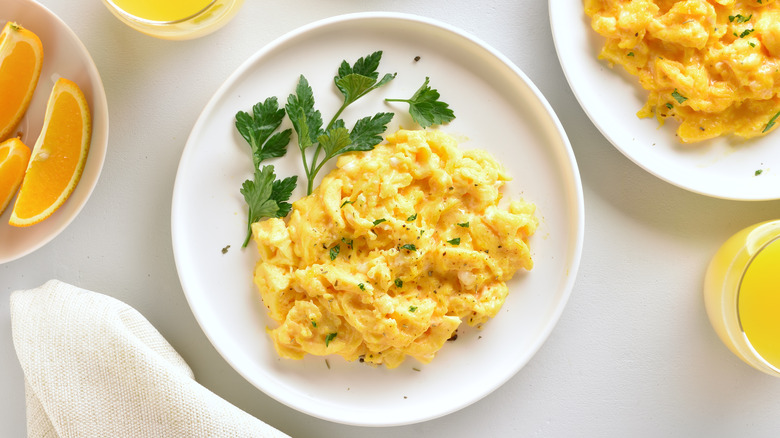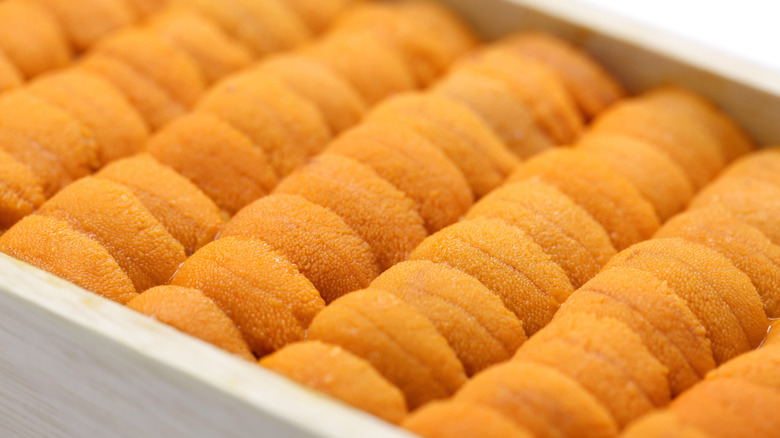The Ridiculously Decadent Ingredient Gordon Ramsay Puts In Scrambled Eggs
Scrambled eggs are about as basic as you can get when it comes to cooking. Using simple techniques and just a few ingredients, virtually anyone can whip up a tasty batch in a hurry. In fact, many people begin their cooking journeys by learning how to cook scrambled eggs thanks to the simplicity of the recipe.
Despite this simplicity, cooking quality scrambled eggs is another consideration entirely. A quick search of the dish online brings back numerous results promising the "perfect" scrambled eggs or the "absolute best" quality you can achieve. The texture is often a big issue, as the most pleasing eggs are fluffy yet lightly firm. Then there are questions about how much seasoning to add and when to add it. While whisking raw eggs in a bowl or while the eggs are cooking? Maybe it's when the eggs are nearly finished cooking?
The ongoing scrambled egg debate shows that just because a dish is simple doesn't mean it can't be improved upon. Additionally, adding certain high-end ingredients can elevate the dish even further and Gordon Ramsay knows this well.
Turning a basic recipe into sophisticated cuisine
While Gordon Ramsay is best known for yelling at restaurant owners and kitchen staff who ignite his fury (courtesy of Channel 4 Entertainment), the infamous celebrity chef is quite acclaimed within the culinary world. The recipient of 17 Michelin Stars throughout the course of his career, Ramsay clearly knows his way around professional kitchens. Additionally, he is always happy to help home cooks amplify simple recipes, including scrambled eggs. As MasterClass reveals, Ramsay is adamant about technique, cautioning chefs against whisking raw eggs or seasoning prior to cooking. He also recommends adding sea urchin tongue to the egg mixture to enhance the flavor profile.
In Ramsay's recipe, he recommends adding one sea urchin tongue to the scrambled eggs near the end of the cooking process, which usually takes about four minutes. Additional ingredients, such as seasonings, chives, and crème fraiche, are added next. The chef also suggests placing one tongue on each plate before layering eggs over them, then topping the dish with any leftover tongues. Sprinkle a few white truffle shavings on the top and the recipe is complete. While Ramsay is clearly a trusted culinary guide, you may be asking yourself: What exactly are sea urchin tongues?
A home chef's guide to uni
The sea urchin tongue Ramsay is referencing is actually the reproductive organs of the spiny aquatic animal. These organs, which are the only edible part of sea urchins, are so-named due to their tongue-like appearance. They're also commonly referred to as uni and are a popular component of sushi. They can be presented as gunkan-maki, which consists of a ball of rice topped with uni and surrounded by seaweed, or as nigiri-sushi, which entails placing a slice of uni atop a hand-molded portion of rice.
As for the taste of uni, flavors can vary according to the sea urchin's diet and other factors. Quality uni is often described as tasting similar to foie gras, with notes of fresh ocean flavors. When it comes to texture, uni should be creamy but firm for optimum mouth feel. If you're shopping for uni to add to your next batch of scrambled eggs, pay close attention to the color. High-quality uni will be a vibrant orangish-yellow color with excellent firmness. Upon finding a prime selection, you'll soon be enjoying breakfast like a world-class chef.


